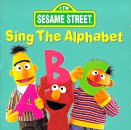Alphabet Learning Songs
Sing the Alphabet by Sesame Street
 Rhythm and Repetition: Songs often have a rhythmic quality that makes them catchy and memorable. The repetitive nature of songs, especially the alphabet song, reinforces the sequence of letters, aiding in retention.
Rhythm and Repetition: Songs often have a rhythmic quality that makes them catchy and memorable. The repetitive nature of songs, especially the alphabet song, reinforces the sequence of letters, aiding in retention.
Melodic Patterns: The melody of a song can help children remember sequences. In the case of the alphabet song, the tune provides a melodic pattern that corresponds with the order of the letters, making it easier for children to recall.
Engagement and Enjoyment: Children are more likely to engage in activities that they find enjoyable. Singing is a fun activity that captures children's attention, making the learning process feel less like a chore and more like play.
Mnemonic Device: Songs serve as mnemonic devices, aiding in memory retention. The combination of melody and rhythm creates a pattern that helps children remember information, in this case, the sequence of the alphabet.
Active Participation: Singing the alphabet song encourages active participation. As children sing along, they are actively practicing the sequence of letters, reinforcing their learning.
Multi-sensory Learning: Songs engage multiple senses. Children hear the song, sing it out loud, and often accompany it with hand movements or gestures. This multi-sensory approach caters to different learning styles and enhances memory retention.
Social Interaction: Singing songs, including the alphabet song, is often a group activity. When children sing together, they learn from each other, correct each other, and reinforce the sequence of letters collectively.
Songs, with their combination of melody, rhythm, and repetition, provide a powerful tool for teaching children the alphabet. They transform learning into an enjoyable and interactive experience, making it easier for children to remember and recite the sequence of letters.
- ABC-DEF-GHI - Elmo
- A-The Sound Of The Letter 'A' - Big Bird
- B-Oscar's 'B' Sandwich - Oscar The Grouch
- C-'C' Is For Cookie - Cookie Monster And The Company
- D-Dee, Dee, Dee - Ernie
- E- What's My Letter? - Guy Smiley And Prairie Dawn
- F-Four Furry Friends - Grover, Herry Monster, Oscar The Grouch And Cookie Monster
- G-Two 'G' Sounds - Grover And George
- H-Ha Ha - Harvey Kneeslapper, Herry Monster And Big Bird
- I-I Stand Up Straight And Tall - Grover
- J-'J' Friends - The Anything People
- K-Herb's Silly Poem - Herbert Birdsfoot
- L-La La La - Bert and Ernie
- M-MMM Monster Meal - Herry Monster And Cookie Monster
- N-The Noodle Story - Big Bird And Oscar The Grouch
- O-Would You Like To Buy An 'O'? - The Salesman And Ernie
- P-My Favorite Letter - The Anything People
- Q-The Question Song - Grover And A Little Girl
- R-The 'R' Machine - Ernie And Bert
- S-Sammy The Snake - Sammy The Snake
- T-The Tale Of Tom Tattertall Tuttletut - Herbert Birdsfoot And The Anything People
- U-'U' Lecture - Professor Hastings
- V- Very, Very Special Letter - Big Bird
- W-The National Association Of 'W' Lovers - Bert
- X-'X' Marks The Spot - Sherlock Hemlock
- Y-Just Because - Grover And A Little Girl
- Z-The Zizzy Zoomrs - The Anything People
